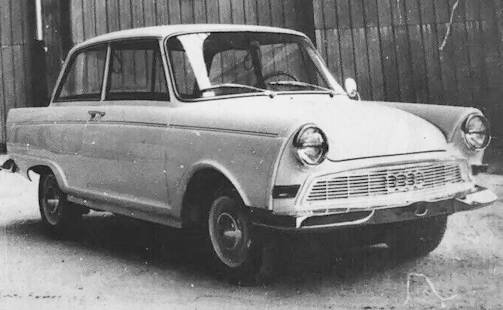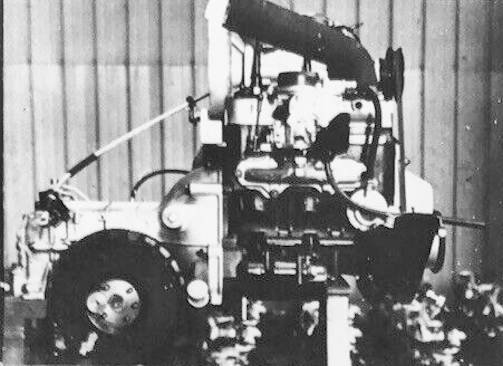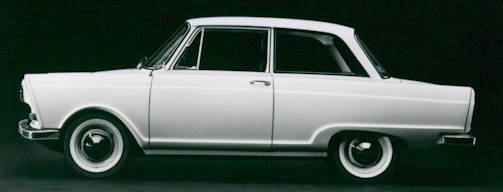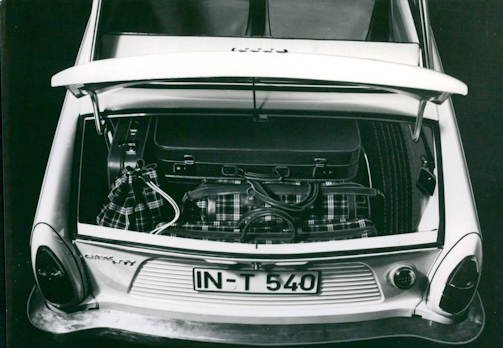DKW F11
 |
|
|
Production period: |
1963 to 1965 |
|
Class : |
Motor car |
|
Body versions : |
Sedan |
|
Engines: |
Gasoline : 0.8 liters 2 stroke; 3 cylinders |
|
Length: |
156.22 in, 3,968 mm |
|
Width: |
62.01 in, 1,575 mm |
|
Height: |
57.20 in, 1,453 mm |
|
Wheelbase : |
88.58 in, 2,250 mm |
|
Curb weight : |
1,610 1b, 730 kg |
The DKW F11 was small cars of the automobile manufacturer Auto Union in the 1960s .
History
The car introduced at the same time as the DKW F102 in August 1963 was a simplified reduced specification version of the DKW F12 with its body, but technically a simple Junior de Luxe with a 34 hp engine with cast iron block and light alloy cylinder head with a displacement of 796 cc fitted with 1 Solex 40 CIB downdraught carburettor. The F11 was offered until June 1965.
Shapely in the lines, powerful in expression, functional in conception, this five-seater offers with low upkeep and maintenance costs medium great performance. The valveless three-cylinder engine with 796 ccm has 34 hp (39 SAE) with the stepwise AUTO.In conjunction with front-wheel drive, contact steering, a well-balanced suspension and exemplary brakes, it develops optimal driving characteristics. Windshield washer system and ignition steering lock included as standard start-repeat lock On with automatic"Saxomat" clutch and sliding roof available. With box-type ladder frame chassis.The front suspension was independent, wishbones,longitudinal torsion bars with telescopic dampers at the rear rigid axle, swinging longitudinal trailing arms, transverse torsion bars, transverse linkage bar, and telescopic dampers, The distribution of weight: 60% front axle, 40% rear axle.

After the takeover by the Volkswagen factory , the Auto Union stopped in March 1966, the production of two-stroke cars finally. The SUV DKW Munga was built until December 1968 for the German Armed Forces . Due to the insufficient market success of the two-stroke engines, which were considered obsolete, the company was on the brink of insolvency.

PERFORMANCE
- Engine capacity:48.57 cu in, 796 cu cm
Fuel consumption: 38.7 m/imp gal, 32.2 m/US gal, 7.3 1 x 100 km
Max speed: 73.3 mph, 118 km/h
max power (SAE): 39 hp at 4,600 rpm
max torque (DIN): 52 1b ft, 7.2 kg m at 2,500 rpm
max engine rpm: 4,800
specific power: 49 hp/l
max speeds: 23.6 mph, 38 km/h in 1st gear; 38.5 mph, 62 km/h
in 2nd gear; 55.9 mph, 90 km/h in 3rd gear; 73.3 mph, 118 km/h in 4th gear
cooling system capacity: 12.67 imp pt, 15.22 US pt
power-weight ratio: 41.2 lb/hp, 18.7 kg/hp
acceleration: standing 1/4 mile 22.4 sec, 0—50 mph (O—80km/h) 14.8 sec

Technical
-
DKW F11 Technical details and specifications (1963-1965)
ENGINE
location front
2 stroke; cylinders: 3, vertical, in line
bore and stroke: 2.78 x 2.68 in, 70.5 x 68 mm
engine capacity: 48.57 cu in, 796 cu cm
compression ratio 7-7.25
cylinder block: cast iron
cylinder head: light alloy
crankshaft bearings: 4, on ball bearings, connecting rods on roller bearings
lubrication: mixture 1 : 40, separate oil tank
carburation:1 Solex 40 CIB downdraught carburettor
fuel feed: pneumatic pump
cooling system: waterTRANSMISSION
driving wheels: front; clutch: single dry plate
gearbox: mechanical; gears: 4 + reverse
synchromesh gears: I, II, III, IV
gearbox ratios: I 3.750,II 2.230, III 1.410, IV 0.940, rev 3.370
gear lever: steering column
final drive: spiral bevel
axle ratio; 4.125.
(Optional) Saxomat automatic clutch
(Optional)free-wheel on transmission.CHASSIS
box-type ladder frame
front suspension: independent, wishbones,longitudinal torsion bars, telescopic dampers
rear suspension: rigid axle, swinging longitudinal trailing arms, transverse torsion bars, transverse linkage bar, telescopic dampers.STEERING
rack-and-pinion
turns of steering wheel lock to lock: 2.25.
turning circle (between walls): 32.8 ft, 10 mBRAKES
drum, 2 front leading shoes
area rubbed by linings: total 149 sq in,961.05 sq cm.ELECTRICAL EQUIPMENT
voltage: 6 V
battery: 56 Ah
generator type: dynamo,60 W
ignition distributor: BoschDIMENSIONS AND WEIGHT
wheel base: 88.58 in, 2,250 mm
front track: 47.24 in, 1,200 mm
rear track: 50.39 in, 1,280 mm
overall length: 156.22 in, 3,968 mm
overall width: 62.01 in, 1,575 mm
overall height: 57.20 in, 1,453 mm
ground clearance: 6.61 in, 168 mm
dry weight: 1,610 1b, 730 kg
distribution of weight: 60% front axle, 40% rear axle© Motor car History
Service
-
DKW F11 Maintenance and Service Guide (1963-1965)
fuel: mixture, 80-85 oct petrol, SAE 20, oil tank,6.69 imp pt, 8.03 US pt, 3.8 1
gearbox and final drive oil: 3.17 imp pt, 3.81 US pt,1.8 1, SAE 90, change every 18,600 miles, 30,000 km
greasing: every 6,200 miles,10,000 km, 10 points
normal tyre pressure: front 21 psi,1.5 atm, rear 21 psi, 1.5 atm.
width of rims:
4"; tyres: 5.50 x 13
fuel tank capacity: 7.7 imp gal, 9.2 US gal.
carrying capacity: 882 1b, 400 kg© Motor car History
Manuals
-
DKW Auto Union Previous 10 / 26 Next
